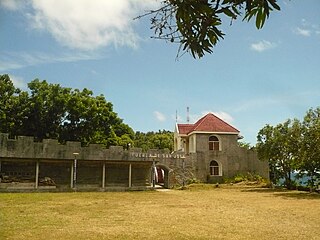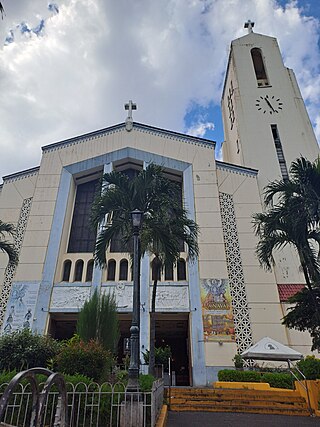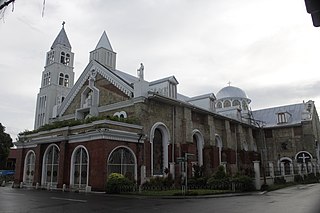
Romblon, officially the Province of Romblon, is an archipelagic province of the Philippines located in the Mimaropa region. Its main components include Romblon, Romblon, an archipelagic municipality of the same name that also serves as the provincial capital; Tablas, the largest island, covering nine municipalities; Sibuyan with its three towns; as well as the smaller island municipalities of Corcuera, Banton, Concepcion, San Jose. The province lies south of Marinduque and Quezon, east of Oriental Mindoro, north of Aklan and Capiz, and west of Masbate. According to the 2020 census, it has a total population of 308,985.

Banton, officially the Municipality of Banton, is a 5th class municipality in the province of Romblon, Philippines. According to the 2020 census, it has a population of 5,737 people.

The Cebu Metropolitan Cathedral, officially known as the Metropolitan Cathedral and Parish of St. Vitalis and of the Immaculate Conception, is the ecclesiastical seat of the Metropolitan Archdiocese of Cebu in Cebu, Philippines. Cebu was established as a diocese on August 14, 1595. It was elevated as a metropolitan archdiocese on April 28, 1934, with the dioceses of Dumaguete, Maasin, Tagbilaran, and Talibon as suffragans. Before being raised as a primatial church in Cebu, the church was one of the first churches in the Philippines dedicated to St. Vitalis and built near the fort in April 1565 by Miguel Lopez de Legazpi, Fray Andrés de Urdaneta and Fray Diego de Herrera.

The Our Lady of Remedies Parish, also known as Malate Church, is a Roman Catholic parish church in the district of Malate in the city of Manila, Philippines. This Mexican Baroque-style church is overlooking Plaza Rajah Sulayman and, ultimately, Manila Bay. The church is dedicated to Nuestra Señora de los Remedios, the patroness of childbirth. A revered statue of the Virgin Mary in her role as Our Lady of Remedies was brought from Spain in 1624 and stands at the altar.

The National Shrine of Our Lady of the Candles, also known as the Metropolitan Cathedral of Saint Elizabeth of Hungary and colloquially as Jaro Cathedral, is a cathedral located in the district of Jaro in Iloilo City, on the island of Panay in the Philippines. The seat of the Roman Catholic Archdiocese of Jaro, it was placed under the patronage of Saint Elizabeth of Hungary. It was established in 1575 as a visita (chapel-of-ease) of Oton by the Augustinians and as a separate parish in 1587. The present-day structure of Jaro Cathedral was built in 1874.

The Basílica Minore del Santo Niño de Cebú, also known as the Minor Basilica of the Holy Child and the Santo Niño Basilica, is a minor basilica in Cebu City in the Philippines that was founded in 1565 by Fray Andrés de Urdaneta and Fray Diego de Herrera. It is the oldest Roman Catholic church in the country, allegedly built on the spot where the image of the Santo Niño de Cebú was found during the expedition of Miguel López de Legazpi.

The San Fernando de Dilao Parish, also known as Paco Church, is a parish church located in the district of Paco in the city of Manila, Philippines, honoring the Castillian king Saint Ferdinand III of Castile. From February 7, 2012 to April 9, 2014, the parish was used as the pro-cathedral of Manila, during the structural renovations of the Manila Cathedral. The church inside is notable for its Romanesque-Byzantine interior with recently Italian Baroque styled altar, most notably the Latin inscriptions similar in style to Saint Peter's Basilica in Rome.

The National Shrine of Our Lady of the Abandoned, also known as the Santa Ana Church, is a Spanish colonial period church located in the district of Santa Ana in Manila, Philippines. The parish was established by the Franciscan missionaries in 1578 under the patronage of Saint Anne. The present stone church was constructed by Vicente Inglés from 1720 to 1725 and was dedicated to its present patron, the Our Lady of the Abandoned. The revered image of its patron was made in Valencia, Spain in 1713 and arrived in the Philippines in 1717.

The Saint Nicholas of Tolentino Parish Church, commonly known as Banton Church, is a Roman Catholic church in the municipality of Banton in Romblon province in the Philippines. It is allegedly one of the oldest churches in the country, constructed between 1644 and 1650 during the Spanish colonial period. The façade and tower of the present church is Modern.

Santo Domingo Church, formally known as the National Shrine of Our Lady of the Holy Rosary of La Naval de Manila, is a Roman Catholic national shrine and parish church in Quezon City, Metro Manila in the Philippines. Dedicated to Mary, mother of Jesus under her title Our Lady of the Most Holy Rosary — La Naval de Manila, it was founded by the Dominicans in 1587.

The San Gregorio Magno Parish , also known as Majayjay Church and St. Gregory the Great Parish Church, is one of the oldest Roman Catholic churches in the Philippines located in the municipality of Majayjay in Laguna. It is recognized by the National Museum as a National Cultural Treasure.

La Purisima Concepcion de la Virgen Maria Parish Church, commonly known as Baclayon Church, is a Roman Catholic church in the municipality of Baclayon, Bohol, Philippines within the jurisdiction of the Diocese of Tagbilaran. Baclayon was founded by the Jesuit priest Juan de Torres and Gabriel Sánchez in 1596, and became the oldest Christian settlement in Bohol. It was elevated as a parish in 1717 and the present coral stone church was completed in 1727. The Augustinian Recollects succeeded the Jesuits in 1768 and heavily renovated the church since then.

The San Agustin Parish Church, also known as the Lubao Church, is a 17th-century Neo-classic, Spanish stone and brick church located at Brgy. San Nicolas 1st, Lubao, Pampanga, Philippines. In 1952, a historical marker bearing a brief history of the structure was installed on the facade of the church by the Historical Committee of the Philippines, precursor of the National Historical Commission of the Philippines. In 2013, the church has been declared by the National Museum of the Philippines as an Important Cultural Property.

The Diocesan Shrine and Parish of San Andres, popularly known as Masinloc Church, is an 18th-century Baroque Roman Catholic church located at Brgy. South Poblacion, Masinloc, Zambales, Philippines. The parish church, dedicated to Saint Andrew the Apostle, is under the jurisdiction of the Roman Catholic Diocese of Iba. The church structure, a standout among Spanish-era churches in the Central Luzon region for having been built with coral stone instead of adobe stone, was declared a National Cultural Treasure by the National Museum of the Philippines along with 25 other Spanish-era churches in 2001.

The Twin Forts of Romblon are a pair of Spanish fortifications located in the town of Romblon, Romblon in the Philippines. It was built by the Spanish in 1644 to protect the town from Muslim raids and Dutch piracy in the country during the Eighty Years' War. In 2013, the site has been declared a National Cultural Treasure under the protection of the Philippine government through the National Museum of the Philippines.

The San Diego de Alcala Parish Cathedral, commonly known as Gumaca Cathedral, is a Baroque-style, Roman Catholic cathedral located at Barangay San Diego Poblacion, in the town center of Gumaca, Quezon province, Calabarzon, Philippines. It is the seat and the mother church of the Diocese of Gumaca.

The Cathedral of Saints Peter and Pauland Parish of Our Lady's Nativity, commonly known as Calbayog Cathedral, is a Roman Catholic cathedral located in the city of Calbayog, Samar province, Philippines. It is the seat of the Diocese of Calbayog, a suffragan of the Palo Archdiocese. Being the first cathedral designated in Eastern Visayas in 1913, it is considered as the mother church of the region.

The Santo Niño Cathedral, commonly known as the Calapan Cathedral is a Roman Catholic cathedral in Calapan, Oriental Mindoro, Philippines, dedicated to the Santo Niño. It is the episcopal seat of the Apostolic Vicariate of Calapan and is a marked historical structure by the National Commission for Culture and the Arts.

Tagbilaran Cathedral, officially named as the Diocesan Shrine and Cathedral-Parish of Saint Joseph the Worker, is a Roman Catholic cathedral in Tagbilaran, capital city of Bohol province, in Central Visayas, Philippines. It is the seat of the Diocese of Tagbilaran which comprises Bohol's western half. The cathedral is located in Tagbilaran poblacion and was installed with a historical marker by the NHCP in 1953.

Fuerza de San José is a 17th-century Spanish fortification located in the municipality of Banton, on the homonymous island, in Romblon, Philippines. Together with Fuerza de San Andrés and Fuerza de Santiago, it is part of the ancient fortification system of the Sibuyan Sea islands, built under the command of Agustín de San Pedro in order to defend the locals from the attacks that devastated the coasts of the archipelago, especially Moorish incursions from the southern islands. Considered by locals a symbol of greatness and resistance, it played a fundamental role in the defense of Banton in the first decades of Spanish rule of the region, and witnessed numerous battles.





























